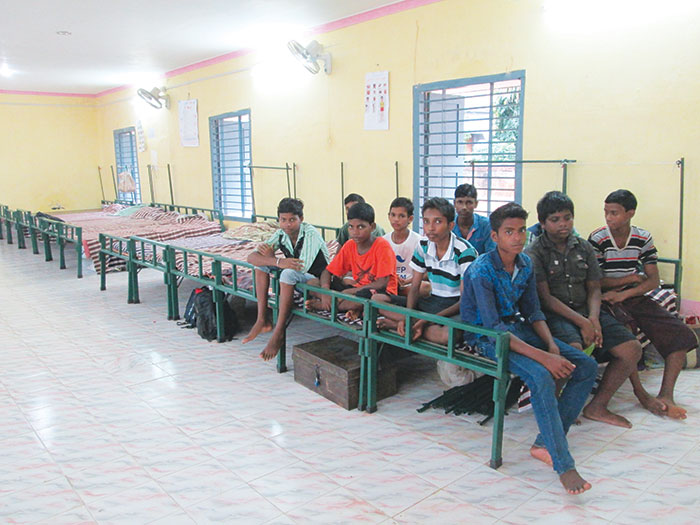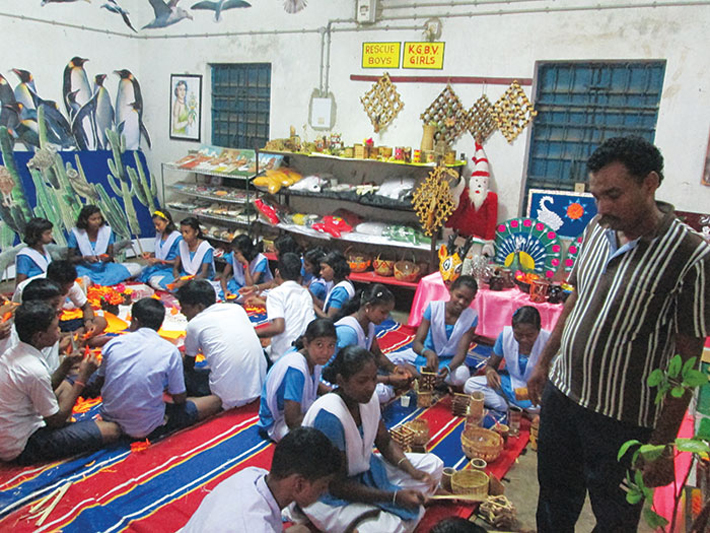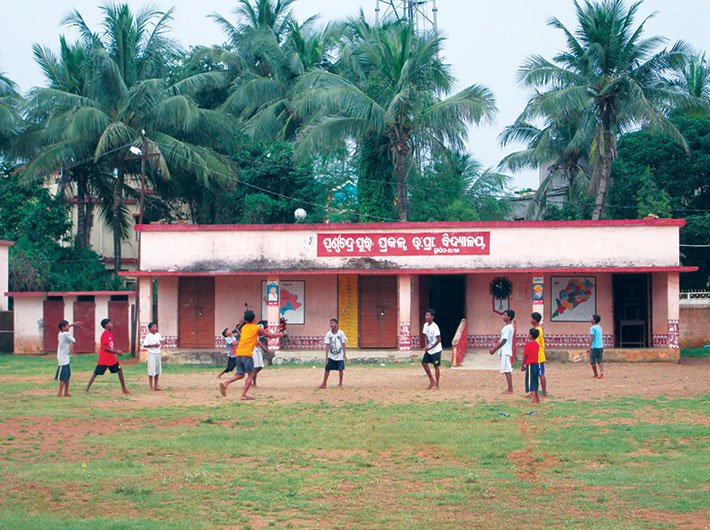A new model of education is helping Odisha’s Mayurbhanj, one of India’s largest districts, become child labour-free by October
As the sky starts to turn dark, noises of children from the playground of the Bisoi government nodal upper primary school, in Mayurbhanj district of Odisha, slowly fade away. The students line up to go to their hostel, within the school premises, to have dinner. White rooms of the Residential Hostel for Urban Deprived, appear dull, stained with black spots from inside, but for some kids it is their new home, at least for a few years. Gudu Patra, a class 9 student, lives in this special rescue centre, also known as a conditional camp.
Gudu was a child labourer until recently when he was saved by a child rescue team from Mayurbhanj district in January. He used to wash dishes at a small eatery for '2,000 a month. Gudu’s income made a significant contribution to the otherwise meagre income of his tribal family comprising of a mother, sister, grandmother and maternal uncle. His family lives in a small, rented hut near Takatpur village, 53 km away from his new home. After Gudu’s exit his family has been struggling to make ends meet. Yet, there was a smile on their faces seeing their child in the camp. “He will bring home some respect with education,” says Titu Patra, Gudu’s maternal uncle, who was once a child labourer himself.
This campaign is owned by the people: Rajesh Prabhakar Patil, district magistrate, Mayurbhanj
“I too sometimes wish I was rescued when working at a hotel for '20 a day during my childhood,” says Titu, who stands in a corner of the rented hut. In a red, worn and torn t-shirt, he now sees his lost childhood revived in Gudu. “It’s better to do something respectful in this world,” he says in fluent Hindi that he had learned in school. When Gudu visits his family during holidays, he shares with them his dream – of becoming like district collector Rajesh Prabhakar Patil, who started the mission of rescuing child labourers and ensuring their education and rehabilitation.
The ‘Mu Bi Padhibi’ [I will learn too] programme, conceptualised by Patil, was launched on April 1, 2013 in the state. It falls under the larger umbrella of the sarva shiksha abhiyan (SSA), which aims to ensure universal access to elementary education to every child in the country. The programme focuses on enrolling children who are drop-outs, labourers, enrolled but never attended school, never-enrolled and have single parents or are orphans. The district administration has opened 52 residential training centres (RTCs) for children under this scheme. At these centres, children are given basic education with respect to their appropriate class before shifting them to a mainstream school.

A group of child labourers rescued in August, at PC Pur Residential Hostel for Urban Deprived
“We have identified almost 5,000 such children and have compiled their data. We have also assessed their situation that is keeping them away from schools. We have counselled the parents and supported them through various central and state government schemes. Then as per the need of a child, we have admitted them to appropriate schools. Many children are kept in these rescue centres,” says Diganth Rotray, district project coordinator, SSA.
In 2014, the administration started focusing mainly on child labourers. “They were enrolled in schools but never attended classes because they were always at their work places,” Rotray says. To ensure that these children do not return to the same life again, the administration opened three new centres in the district where only child labourers were kept for rehabilitation.
In the past two years, 331 child labourers have been rescued, says Mamta Mai Biswal, district child protection officer. Raids were conducted at various tea stalls, dhabas, brick kiln factories and agricultural lands in the district to rescue children. “Such raids will continue. By October this year we are planning to declare the district child labour-free,” says Rotray.
Strengthening his conviction, Gudu says, “I want not only this district but the entire world free of child labour.” Gudu gives us a handmade card and a paper flower as a parting gift. He has learned this skill from his craft teacher at the centre.
Like Gudu, there are 110 boys living in the centre which was built in 2014 for rescued child labourers. Children are admitted to this centre after a health check-up and bone test to determine their exact age. Following a counselling session with the children and their parents, the kids are admitted to appropriate classes. The main focus of this programme is to make these children feel at home. Hence, for the first two months, children are set free on playgrounds and are involved in various activities like music, dance, art and craft. They also make toys from clay, pen stands from bamboo sticks, and play badminton, football and chess. Gradually they are taught about other subjects that prepare them for the mainstream education. So after two years, when they are shifted to a mainstream school, they do not feel left out. This process
of rehabilitation is administered under strict supervision of teachers.
“Earlier when child labourers were rescued they were kept in rehabilitation centres for only one or two days. After that they were taken to the child welfare committee and later handed over to their parents. Months later, we used to find them working in the same places,” says Rotray.

Para-teacher Gunakar Behra with students in the craft room of Bisoi government school. The room is full of craftworks by children
“Now we keep them in special centres. We admit them to schools and hostels and involve them in extracurricular activities and prepare them for mainstream education,” he adds.
But this whole process is not as easy as it looks. “Initially it is difficult. Rescued children get aggressive when we bring them here. Their parents trouble us; hurl abuses at us for taking away their source of income. But when we counsel them about their child’s education and ensure financial support to them under various government schemes, they agree to support us,” says Mamta Mai Biswal. She adds that when parents meet them after months and see the progress of their child, “they touch our feet in gratitude and give us blessings”.
Mayurbhanj district also has two other special rescue centres – one in PC Pur for boys, opened in March 2016 with 38 children, and one for girls in Takatpur, opened in 2013 with 26 kids. These centres have given hopes to many child labourers like Gudu. One of them is Madhusmita Sahi, 15, a class 7 tribal girl who lives in the rescue centre of the MTK government upper primary school, Takatpur, in Baripada town. After being rescued in December last year from a home where she worked as a helper, Madhusmita is finally able to do what she loves. “I want to play like [PV] Sindhu,” she says with a wide grin on her face.
She read about Sindhu’s Olympian feat in a local newspaper. Her favourite sport, however, is kabbadi that she plays with her new friends at the school. “I don’t feel like going back to my village. Here I can play and study without any distraction,” she says.
The attendance in government schools in the district has gone up with the programme – from 67 percent in 2012 to 91 percent in 2014 and 92 percent in 2015.
Managing funds
Different government schemes support the funding of the programme. Around 90 percent of the funds are utilised from SSA and the remaining 10 percent from the integrated action plan (IAP) and backward region grant (BRG). “Earlier funds were not utilised properly. We converged these two funds [IAP and BRG] and decided to spend them rationally to fulfill the mandate of right to education,” Rotray says. After this arrangement, so far the district administration has not asked for extra funds from the government to run this programme, claims Rotray.
Facilitating teachers
Not only students, but arrangements have also been made for the teachers by the district administration, so that they don’t skip school and not let the students suffer. Take residential quarters for teachers for example.
Some 25 km away from Jashipur block, crossing the Similipal forest reserve, there is a cluster of three gram panchayats where tribal families live in isolation. In Gurugudia gram panchayat, there are total 12 schools and 871 students.
Schools there, however, face absence of teachers because most of them come from Jashipur block and other areas, which are far away from the village. Crossing the vast forest areas becomes a scary task for the teachers, especially females.
Pradip Kumar Naik has been a mathematics teacher at the Gurugudia Project Upper Middle School since 2007. He lives in Badanoi village, which is 10 km from Jashipur block, and has to travel more than 30 km to reach the Gurugudia school, on a truck or bus. “It takes at least three hours to reach the school. Going back in the night is dangerous as there is a long stretch of forest with no mobile coverage at all,” he says. This often affected his attendance at school, he confesses. So for some days in a week, Naik began staying at a youth club in Gurugudia gram panchayat. “We lived there because there was no choice,” he sighs. “There was no facility at all. No water, no electricity.
The place was unfit for living,” he adds.
For the past two months now, he has been living in teachers’ barrack built this year by the district administration to improve their attendance. The place gets electricity through solar power connection and has capacity for 25 male teachers and 25 female teachers. At present, 11 male teachers and three female teachers live in the barracks for five days a week. Teachers from nearby gram panchayats are demanding a similar facility, says Ram Chandra Naik, cluster research centre coordinator, Jashipur block.
Teachers’ concerns
Pradip Kumar Naik, who is a permanent teacher, however, says that less salary is another concern for teachers here. He says that after 10 years of service, he only earns '17,000 a month. “It is not sufficient to sustain a family,” he says in a hesitant tone. Naik and his elder brother, who works as a security guard, are the only breadwinners for their family of eight.
For para-teachers, the condition is even worse. Gunakar Behra, in his mid-thirties, has been teaching craft to the students of the Bisoi government school for three years now. He, however, earns only '3,500 a month. Even though his accommodation and food is free of cost at the school, he says sustaining a family with this salary is a challenge. “The collector has assured that he will help me get a home under the pradhan mantri gramin awaas yojana,” he says.
Patil, however, clarifies, “Low salary is not an issue since there is an assurance of it getting regularised. At the end of the day, we cannot see education as a lucrative business.”
taru@governancenow.com
(The story appears in the September 16-30, 2016 issue)

